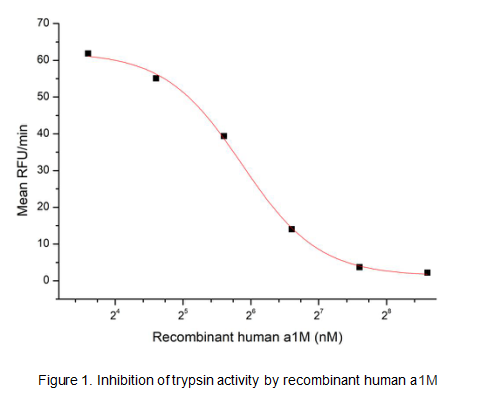Active Alpha-1-Microglobulin (a1M) 

AMBP; UTI; HCP; EDC1; HI30; IATIL; ITILC; ITI; ITIL; Alpha 1 Microglobulin/Bikunin Precursor; Growth-inhibiting protein 19; Uristatin; Uronic-Acid-Rich Protein; Trypstatin
- UOM
- FOB US$ 284.00 US$ 710.00 US$ 1,420.00 US$ 4,260.00 US$ 10,650.00
- Quantity
Overview
Properties
- Product No.APA217Hu61
- Organism SpeciesHomo sapiens (Human) Same name, Different species.
- ApplicationsCell culture; Activity Assays.
Research use only - DownloadInstruction Manual
- CategoryInfection immunityImmune moleculeKidney biomarker
- Buffer FormulationPBS, pH7.4, containing 5% Trehalose.
- Traits Freeze-dried powder, Purity > 95%
- Isoelectric Point5.8
Sign into your account
Share a new citation as an author
Upload your experimental result
Review

Contact us
Please fill in the blank.
Activity test

Alpha-1-Microglobulin (a1M) is a small protein belonging to the superfamily of lipocalins, which is present in various body fluids such as plasma and cerebrospinal fluid. it has a role in the transportation of molecules like metals and serves as a marker for certain diseases, including kidney and liver disorders.The activity of recombinant human A1M was measured by its ability to inhibit trypsin cleavage of a fluorogenic peptide substrate MCA-Arg-Pro-Lys-Pro-Val-Glu-NVAL-Trp-Arg-Lys(DNP)-NH2 in the assay buffer 50 mM Tris, 10 mM CaCl2, 150 mM NaCl, 0.05% (w/v) Brij-35, pH 7.5. Trypsin was diluted to 50 ug/ml in the assay buffer and 25 ul different concentrations of recombinant human a1M (MW: 64 KD) was incubated with 25ul diluted trypsin at 37 ℃ for 15 minutes.Loading 50 µL of the incubated mixtures which were diluted five-fold in assay buffer into empty wells of a plate, and start the reaction by adding 50 µL of 20 µM substrate.nclude a substrate blank containing 50 µL of assay buffer and 50 µL of 20 µM substrate.Then read at excitiation and emission wavelengths of 320 nm and 405 nm, respectively, in kinetic mode for 5 minutes.The result was shown in Figure 1 and it was obvious that recombinant human a1M significantly decreased trypsin activity. The inhibition IC50 was <58 nM.
Usage
Reconstitute in 10mM PBS (pH7.4) to a concentration of 0.1-1.0 mg/mL. Do not vortex.
Storage
Avoid repeated freeze/thaw cycles. Store at 2-8°C for one month. Aliquot and store at -80°C for 12 months.
Stability
The thermal stability is described by the loss rate. The loss rate was determined by accelerated thermal degradation test, that is, incubate the protein at 37°C for 48h, and no obvious degradation and precipitation were observed. The loss rate is less than 5% within the expiration date under appropriate storage condition.
Increment services
-
 BCA Protein Quantification Kit
BCA Protein Quantification Kit
-
 Molecular Mass Marker for Protein
Molecular Mass Marker for Protein
-
 Monoclonal Antibody Customized Service
Monoclonal Antibody Customized Service
-
 Polyclonal Antibody Customized Service
Polyclonal Antibody Customized Service
-
 Protein Activity Test Experiment Service
Protein Activity Test Experiment Service
-
 Electrophoretic Mobility Shift Assay (EMSA) Experiment Service
Electrophoretic Mobility Shift Assay (EMSA) Experiment Service
-
 Buffer
Buffer
-
 Lentivirus Packaging Experiment Service
Lentivirus Packaging Experiment Service
-
 Adenovirus Packaging Experiment Service
Adenovirus Packaging Experiment Service
-
 Real Time PCR Experimental Service
Real Time PCR Experimental Service
-
 Spike RBD Protein (S-RBD)
Spike RBD Protein (S-RBD)
-
 Protein G
Protein G
-
 Protein A
Protein A
Citations
- Proteomic Identification of Human Urinary Biomarkers in Diabetes Mellitus Type 2 Liebert: 20100078
- Effect of high dose thiamine on the levels of urinary protein biomarkers in diabetes mellitus type 2PubMed: 21130593
- Proteomic Profiling for Peritoneal Dialysate: Differential Protein Expression in Diabetes MellitusPubMed: PMC3679811
- Identifizierung neuer potentieller Biomarker für das Kolonkarzinom sowie dessen VorstufenInfo:Source
- Activated Α7nachr Improves Postoperative Cognitive Dysfunction and Intestinal Injury Induced by Cardiopulmonary Bypass in Rats: Inhibition of the Proinflammatory …Pubmed:29672286
- Urinary Proteomics for the Early Diagnosis of Diabetic Nephropathy in Taiwanese PatientsPubmed: 30486327







